This is an excerpt of the paper below, with the title above, focusing on the topic of the publication.
Preventable risk factors of dementia: Population attributable fractions in a Brazilian population-based study
The Lancet Regional Health — Americas
Wyllians Vendramini Borelli
Vanessa Bielefeldt Leotti
Matheus Zschornack Strelow
Márcia Lorena Fagundes Chaves
Raphael Machado Castilhos
April 07, 2022
Findings (Overview)
The ten preventable risk factors for dementia accounted for 50·5% of the Population Attributable Fraction in Brazil.
- Hearing loss (14·2%),
- physical inactivity (11·2%), and
- hypertension (10·4%) accounted for the highest PAF among all the risk factors.
Considerable variation in the relative contribution of the different risk factors was found in different regions.
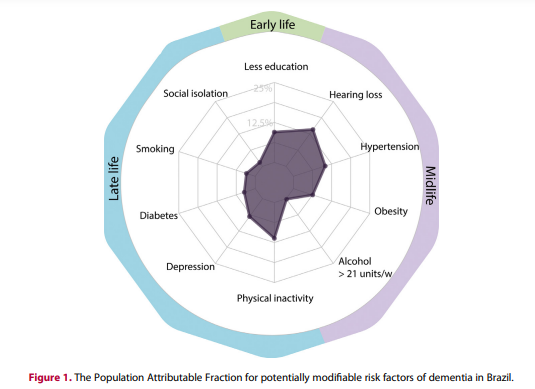
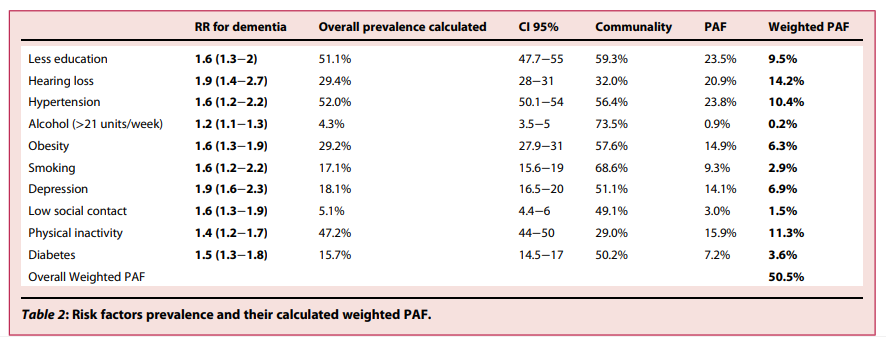
Regionally, the prevalence of modifiable risk factors exhibited a distinct profile.
- The prevalence of individuals with a low education level was the highest in the northeast (69·9%), while the highest rate of depression was observed in the south (26·8%).
- Individuals in the northeast also had the highest rates of hearing loss (34%), physical inactivity (55·8%), and social isolation (5·7%).
- Individuals from the southeast had the highest rates of hypertension (54%), obesity (30·3%), excessive alcohol consumption (5·7%), and diabetes (17·1%). Individuals from the midwest presented the highest rate of smoking (17·7%) (Figure 2).
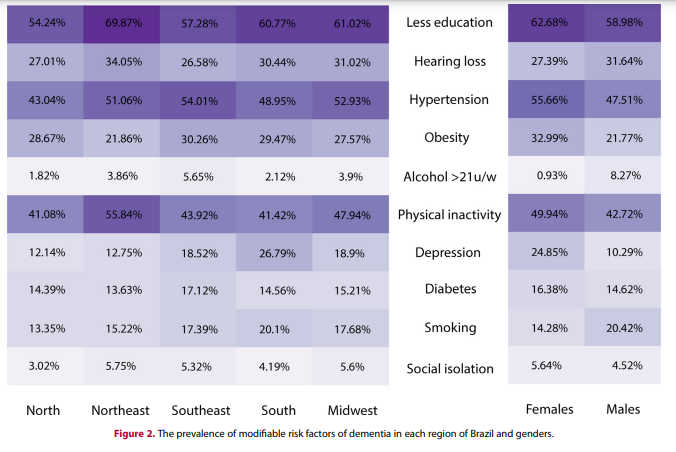
Discussion [excerpt]
Only ten risk factors were enough to demonstrate a higher PAF in Brazil than the PAF calculated for high-income countries. 3
Approximately half of the cases of dementia are potentially preventable in Brazil, compared to 39·7% of the cases estimated for HIC and 41·2% of the cases estimated for LMIC. 4
Interestingly, Spanish-speaking Latin America presented a similar overall PAF (55·8%), which was estimated by the 10/66 Dementia Research Group.
Furthermore, Latin America and Brazil showed a similar PAF for the majority of the presented risk factors, except for a higher weighted PAF for hearing loss (14·2% vs. 7·7%) and physical inactivity (11·2% vs. 4·5%), and lower for smoking rate (2·9% and 5·7%).
Rigorously managing the risk factors might decrease over 300,000 new cases of dementia by 2050 in Brazil. 9
Understanding regional differences for each modifiable risk factor could guide public health policies. 10
Rigorously managing the risk factors might decrease over 300,000 new cases of dementia by 2050 in Brazil. 9
We performed a detailed analysis of each risk factor to provide information to policymakers worldwide.
Discussion about Hearing Loss [excerpt]
Hearing loss had the most robust effect as a potentially modifiable risk factor for dementia in this study.
Almost one-third of the studied population had some type of hearing loss, which was more than that estimated for Latin America or the rest of the world. 2
Self-reported hearing loss is potentially underestimated, as almost one-third of the individuals with confirmed hearing loss reported normal hearing. 11
Theoretically, hearing loss might contribute to cognitive decline due to social and environmental isolation, direct effects on brain structure integrity, and a constant load on cortical resources that otherwise could have buffered other neuropathologies. 12
Hearing loss may be easily underdiagnosed in primary care settings 13 and raising awareness is the first step to decrease its burden.
The World Report on Hearing estimated that 80% of the individuals with hearing loss are from LMIC and comprise 340 million individuals. 14
Screening programs for identifying hearing loss in adults are cost-effective and might mitigate its impact on age-related diseases. Thus, auditory alterations might be critical for primary care interventions.15
Hearing loss may be easily underdiagnosed in primary care settings 13 and raising awareness is the first step to decrease its burden.
Screening programs for identifying hearing loss in adults are cost-effective and might mitigate its impact on age-related diseases. Thus, auditory alterations might be critical for primary care interventions.15
ORIGINAL PUBLICATIONS BELOW

Estudo da UFRGS identifica que metade dos casos de demência no Brasil poderiam ser evitados
Envelhecimento | Acompanhamento adequado de fatores como perda auditiva, inatividade física e hipertensão pode diminuir os casos de demência a longo prazo
UFRGS.BR
Gabhriel Giordani
9 de junho de 2022
Foto: Gustavo Diehl/Arquivo 13 mar. 2019
Um estudo do Instituto de Ciências Básicas de Saúde da UFRGS (ICBS) identificou que cerca de 50% de diagnósticos de demência em adultos no Brasil poderiam ser evitados, caso certos fatores de risco fossem controlados.
Nível de escolaridade, perda auditiva, hipertensão, consumo de álcool, obesidade, tabagismo ativo, depressão, isolamento social, inatividade física e diabetes foram os dez indicadores identificados como determinantes para desenvolvimento da demência e que devem ser adequadamente acompanhados pelos serviços de saúde.
A pesquisa foi publicada na revista The Lancet Regional Health — Americas.
Perda auditiva foi o fator de maior impacto, presente em 14,2% dos pacientes diagnosticados com demência e incluídos no estudo.
Outros aspectos importantes foram inatividade física (11,2%) e hipertensão (10,4%).
Para Wyllians Borelli, autor da pesquisa e pós-doutorando do ICBS, a perda auditiva foi o que causou maior espanto. “Esperávamos, por exemplo, que o impacto de uma baixa escolaridade fosse muito maior, mas não foi, mesmo sendo importante”, relata.
Para ele, a demência acaba sendo subdiagnosticada no Brasil, sem a devida identificação, perpetuando o “esquecimento” como parte do envelhecer.
Para ele, a demência acaba sendo subdiagnosticada no Brasil, sem a devida identificação, perpetuando o “esquecimento” como parte do envelhecer.
O trabalho de Wyllians utilizou uma coorte de base populacional disponibilizada pelo Estudo Longitudinal da Saúde dos Idosos Brasileiros (ELSI-Brasil), banco de dados da Fundação Oswaldo Cruz que estuda determinantes sociais e biológicos do envelhecimento.
A amostra incluiu 9400 participantes de todo o país, com 50 anos de idade ou mais.
Ao separar os indivíduos por região do país, os pesquisadores constataram que, quanto pior o Índice de Desenvolvimento Humano (IDH), maiores são os índices da demência.
Hoje, a região brasileira que mais preocupa é o Nordeste, com maiores índices de analfabetismo (43,5% dos 2.549 residentes na região incluídos na pesquisa), e também com o menor índice de escolaridade entre as cinco regiões do país (4,3 anos). “[Variáveis como]
Ter água encanada, ter escola, ter disponibilidade de alimentos saudáveis gera uma discrepância entre os fatores de risco entre as várias regiões brasileiras”, destaca Wyllians.

Mudança necessária
Para mudar essa realidade, Wyllians alega que, em primeiro lugar, os fatores de risco para demência, em especial a perda auditiva, devem entrar na pauta do debate público.
Segundo, é necessário ampliar a prevenção e o tratamento de doenças comuns na população, como a hipertensão, pelo Sistema Único de Saúde (SUS).
Junto a essas medidas, devem ser feitas políticas públicas voltadas à conscientização da população sobre a demência, para que possa haver prevenção no tempo certo.
Para mudar essa realidade é preciso: (1) combater os fatores de risco para demência, em especial a perda auditiva, (2) ampliar a prevenção e o tratamento de doenças comuns na população, como a hipertensão, pelo (SUS).
Wyllians acredita que o SUS ainda precisa melhorar a estratégia de saúde primária, como melhor capacitação de equipes de saúde e mais atenção aos fatores de risco para demência.
“Eu fico muito otimista ao saber que o SUS tem uma abrangência nacional, e acho que um ponto imprescindível no Brasil que devemos melhorar é implementar mais políticas de saúde pública na atenção básica”, alega o pesquisador.
Essas melhorias atuam a longo prazo e, se implantadas hoje, só teriam resultados observados em 20 ou 30 anos, destaca.
“Isso deveria ser uma força tarefa da própria sociedade em prol dela mesma. Precisa ser colocado em alerta”, conclui.
Wyllians acredita que o SUS ainda precisa melhorar a estratégia de saúde primária, como melhor capacitação de equipes de saúde e mais atenção aos fatores de risco para demência.
Originally published at https://www.ufrgs.br on June 9, 2022.
ORIGINAL PUBLICATION (Summary)
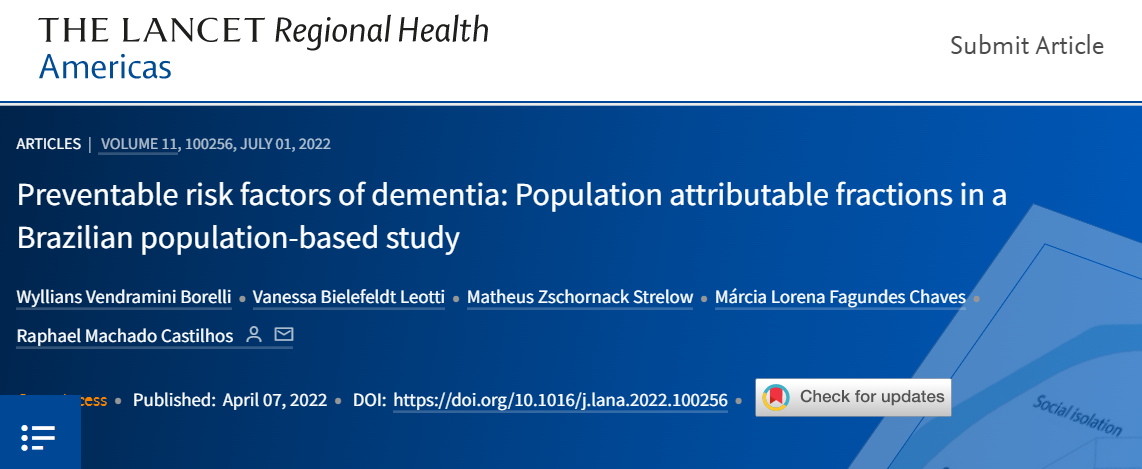
Preventable risk factors of dementia: Population attributable fractions in a Brazilian population-based study
The Lancet Regional Health — Americas
Wyllians Vendramini Borelli
Vanessa Bielefeldt Leotti
Matheus Zschornack Strelow
Márcia Lorena Fagundes Chaves
Raphael Machado Castilhos
April 07, 2022
SUMMARY
Background
Knowledge regarding the modifiable risk factors of dementia is fundamental to guide public health policy.
We aimed to estimate the population attributable fraction of modifiable risk factors of dementia among adults from a nationwide epidemiological study.
Methods
We used the public database of the Brazilian Longitudinal Study of Aging (ELSI-Brazil) to calculate the Population Attributable Fraction (PAF) for ten risk factors, including education level, hearing loss, hypertension, alcohol consumption, obesity, active smoking, depression, social isolation, physical inactivity, and diabetes.
PAF was estimated for this sample after accounting for the communality of each risk factor.
Findings
The ten preventable risk factors for dementia accounted for 50·5% of the Population Attributable Fraction in Brazil.
- Hearing loss (14·2%),
- physical inactivity (11·2%), and
- hypertension (10·4%) accounted for the highest PAF among all the risk factors.
Considerable variation in the relative contribution of the different risk factors was found in different regions.
Interpretation
This study might provide an opportunity to change the impact of dementia in Brazil.
By targeting modifiable risk factors of dementia, the health of individuals in Brazil might be considerably improved.
Funding
This study did not receive any funding.
This study might provide an opportunity to change the impact of dementia in Brazil.
By targeting modifiable risk factors of dementia, the health of individuals in Brazil might be considerably improved.
ORIGINAL PUBLICATION (excerpt)
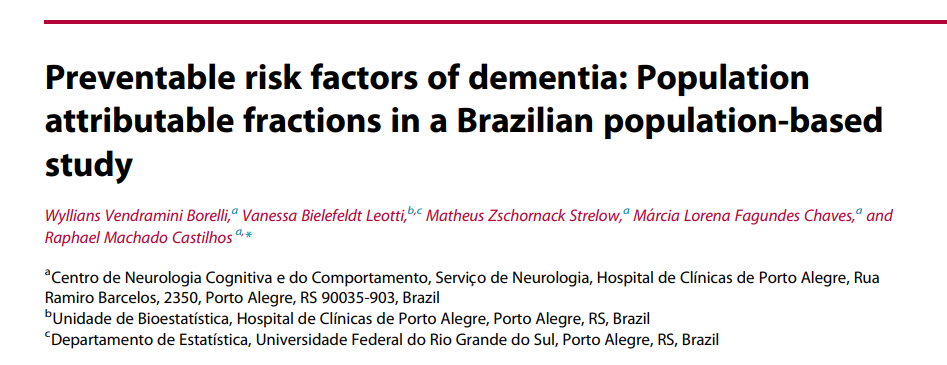
Introduction
A large number of cases of dementia are expected within the next few years across the globe. 1 , 2
High-income countries have demonstrated decreasing rates of dementia, probably associated with rigorous control of vascular risk factors in the last decades. 3
However, the incidence has rapidly increased in low and middle-income countries (LMIC), which account for almost two-thirds of the global population suffering from dementia. 1
Widespread uncontrolled vascular risk factors associated with low education levels synergistically make older people living in LMIC even more vulnerable to cognitive decline. 3
Several modifiable risk factors of dementia have been established, some of them important in early-life (poor schooling), midlife (hearing loss, traumatic brain injury, hypertension, alcohol consumption, and obesity), and late-life (smoking, diabetes, depression, social isolation, physical inactivity, and air pollution).
Mukadam et al. analyzed nine modifiable risk factors of dementia in LMIC and calculated the Population Attributable Fraction (PAF).
For the six Latin American countries analyzed in the study (Brazil not included), the PAF estimated was 55·8%, 4 which was higher than the PAF of high-income countries.
Brazil is a large upper-middle-income country with a unified healthcare system. However, a significant share of the adult population is still exposed to several risk factors of dementia, 5 besides having a low average education level.
Although the adult population of Brazil is large, little is known about the prevalence of risk factors of dementia in this population.
A nationwide epidemiological task force was established under the name ELSI-Brazil (Brazilian Longitudinal Study of Aging) 6 to conduct a longitudinal study with older adults from Brazil.
The data were collected from a nationally representative sample of individuals who were 50 years or older, and ten established potentially reversible risk factors of dementia were included.
We aimed to calculate the population attributable fraction of modifiable risk factors of dementia from Brazilian adults by conducting an epidemiological study.
Methods
See the original publication
Results
The ELSI-Brazil study included 9412 individuals between 50 and 105 years.
We excluded 157 individuals from the study who were previously diagnosed with dementia.
A total of 9255 (56.6% females) individuals were included in this analysis, with an average of 63·4 (SD 10·1) years of age and 5·4 (SD 4·3) years of education.
There were 2413 (26·9%) individuals who could not write or read a note, which was a proxy for illiteracy.
Brown individuals (“Pardo” in Portuguese) comprised the largest proportion of individuals included (4,213, 45·5%), followed by white (3,529, 38·1%), Black (878, 9·5%), Indigenous (217, 2·3%), and Asian (90, 1%) individuals. Region-wise demographic characteristics are presented in Table 1.
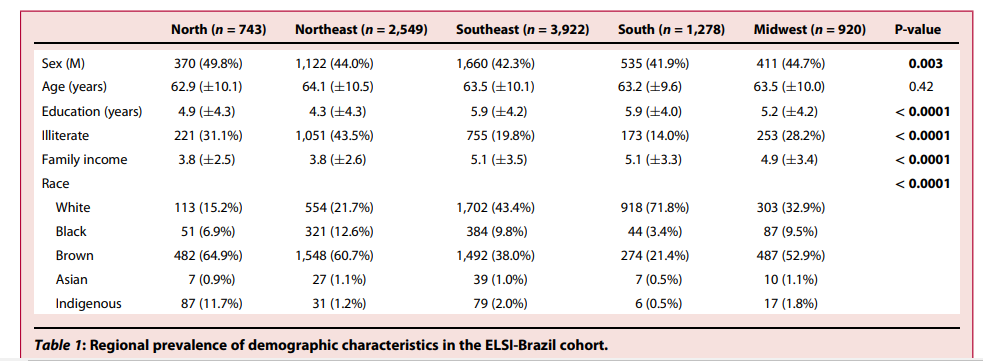
The total weighted Population Attributable Fraction for the ten risk factors of dementia analyzed in Brazil was 50·5%.
- The highest PAF corrected for communality was hearing loss (14·2%), followed by
- physical inactivity (11·2%),
- hypertension (10·4%), and
- low education level (9·5%) (Figure 1).
Importantly, the use of hearing aid was very limited across the nation (165, 1·7%). Table 2 presents all modifiable risk factors of dementia and their respective weighted PAF.


Regionally, the prevalence of modifiable risk factors exhibited a distinct profile.
- The prevalence of individuals with a low education level was the highest in the northeast (69·9%), while the highest rate of depression was observed in the south (26·8%).
- Individuals in the northeast also had the highest rates of hearing loss (34%), physical inactivity (55·8%), and social isolation (5·7%).
- Individuals from the southeast had the highest rates of hypertension (54%), obesity (30·3%), excessive alcohol consumption (5·7%), and diabetes (17·1%). Individuals from the midwest presented the highest rate of smoking (17·7%) (Figure 2).

Discussion
In this study, we calculated the PAF for ten modifiable risk factors of dementia in a large sample that represented the Brazilian population. We found a total weighted PAF of 50·5%, indicating that nearly half of the dementia cases in Brazil are potentially preventable. A previous study also estimated the PAF for the Brazilian population, though with fewer risk factors and using another type of sampling and found a lower PAF of 32·3%.9
Our results were similar to those of a study by Mukadam et al., who found that PAF from six Latin American countries was 55·8%. 4
Population Attributable Fraction estimates are vulnerable to the accuracy of epidemiological data, especially risk factors. The cohort from which we estimated the prevalence of these ten risk factors, ELSI-Brazil, was established according to the international epidemiological guidelines. 6
Furthermore, the complex sampling strategy was previously validated to present national representativeness. This was a major advantage in this cohort compared to the National Health Surveys, where a different methodology was applied. Thus, the estimates in this study accurately reflected the prevalence of risk factors in the country.
Only ten risk factors were enough to demonstrate a higher PAF in Brazil than the PAF calculated for high-income countries. 3
Approximately half of the cases of dementia are potentially preventable in Brazil, compared to 39·7% of the cases estimated for HIC and 41·2% of the cases estimated for LMIC. 4
Approximately half of the cases of dementia are potentially preventable in Brazil, compared to 39·7% of the cases estimated for HIC and 41·2% of the cases estimated for LMIC. 4
Interestingly, Spanish-speaking Latin America presented a similar overall PAF (55·8%), which was estimated by the 10/66 Dementia Research Group.
Furthermore, Latin America and Brazil showed a similar PAF for the majority of the presented risk factors, except for a higher weighted PAF for hearing loss (14·2% vs. 7·7%) and physical inactivity (11·2% vs. 4·5%), and lower for smoking rate (2·9% and 5·7%).
Rigorously managing the risk factors might decrease over 300,000 new cases of dementia by 2050 in Brazil. 9
Understanding regional differences for each modifiable risk factor could guide public health policies. 10
Rigorously managing the risk factors might decrease over 300,000 new cases of dementia by 2050 in Brazil. 9
We performed a detailed analysis of each risk factor to provide information to policymakers worldwide.
Hearing loss
Hearing loss had the most robust effect as a potentially modifiable risk factor for dementia in this study.
Almost one-third of the studied population had some type of hearing loss, which was more than that estimated for Latin America or the rest of the world. 2
Self-reported hearing loss is potentially underestimated, as almost one-third of the individuals with confirmed hearing loss reported normal hearing. 11
Theoretically, hearing loss might contribute to cognitive decline due to social and environmental isolation, direct effects on brain structure integrity, and a constant load on cortical resources that otherwise could have buffered other neuropathologies. 12
Hearing loss may be easily underdiagnosed in primary care settings 13 and raising awareness is the first step to decrease its burden.
The World Report on Hearing estimated that 80% of the individuals with hearing loss are from LMIC and comprise 340 million individuals. 14
Screening programs for identifying hearing loss in adults are cost-effective and might mitigate its impact on age-related diseases. Thus, auditory alterations might be critical for primary care interventions.15
Hearing loss may be easily underdiagnosed in primary care settings 13 and raising awareness is the first step to decrease its burden.
Screening programs for identifying hearing loss in adults are cost-effective and might mitigate its impact on age-related diseases. Thus, auditory alterations might be critical for primary care interventions.15
Education level
The PAF for a low education level in our study was 9·5%. Low educational level is associated with cognitive decline throughout the lifespan. 5
Here, it was defined as less than four years of schooling, and it is a major preventable risk factor of dementia but challenging to improve in LMIC. 16
Illiteracy is not specifically high in Brazil, but unequal distribution of literacy rates exists among states, especially among females (Figure 2). The ELSI-Brazil population sample included individuals born from 1915 to 1965, which was a period of political transitioning in Brazil that impacted education policies. More recent estimates show that 6·6% of Brazilians are illiterate.17
The relative impact of education on dementia in the following generations will probably be lower than that in the one studied here.
Cardiovascular risk factors — such as hypertension, diabetes, smoking, sedentary lifestyle, and obesity
Cardiovascular risk factors such as hypertension, diabetes, smoking, sedentary lifestyle, and obesity are associated with cognition. 18
The PAFs for hypertension, diabetes, physical inactivity, obesity, and smoking were 10·4%, 6·3%, 11·2%, 6·3%, and 2·9%, respectively, accounting for more than a quarter of the overall PAF. Controlling hypertension and diabetes in adults and older adults can decrease the incidence of cognitive decline. 19
However, operational diagnosis and management of these risk factors are still insufficient in primary care but account for the most impactful lifestyle changes. 20
Brazilian adult subjects exhibited a worse clinical profile compared to their English peers, though the frequency of disability was similar for both samples. 21
The ELSI-Brazil cohort included individuals who were 50 years or older. Thus, we were able to measure midlife obesity.
Physical activity can have a direct and indirect impact in preventing dementia, with increasing evidence supporting the positive effect of aerobic exercises. 22
Additionally, a low PAF of smoking in Brazil reflects strong and successful nationwide anti-tobacco policies. 23
Strategies targeted toward gender-associated risk factors might also benefit the population, as females showed more hypertension, obesity, and physical inactivity, while males presented higher rates of substance use.
Overall, making behavioral changes and improving lifestyle habits can enhance the quality of life at old age. 24
Mental health is a major determinant of wellness in older adults. Depression is associated with increased mortality, substantial healthcare, and social costs. 25
Depression presented a weighted PAF of 6·9%, and its prevalence was higher in this study compared to others in the Brazilian population.
In this study, women reported significantly higher instances of depression than men (24% vs. 10%). However, the prevalence of depression in Brazil was lower than that estimated in Latin America 29·9%). 2
The prevalence of depression varies largely among Brazilian studies (3·9% to 17%) 26 , 27 mostly due to different methods of evaluating depression. The relationship between depression and dementia is complex, as severe depression might be a risk factor or a consequence of dementia, 28 where depressive states are suggested as prodromal stages of Alzheimer’s disease.
Finally, we found a low PAF for alcohol consumption and social contact of 0·2% and 1·5%, respectively.
Public health policies might benefit from epidemiological studies like this one. Identifying adults at risk of developing dementia is pivotal for long-term public health planning, but studies on this issue are absent in Latin America. 29 , 30
Latin American countries have one of the highest prevalence rates of dementia worldwide because of their unique characteristics, such as low literacy and multiethnic background. 31
Preventable risk factors comprise a large part of the risk factors of dementia in Latin America. Thus, a coordinated plan to address these factors among nations can benefit the population. 32
Preventable risk factors comprise a large part of the risk factors of dementia in Latin America. Thus, a coordinated plan to address these factors among nations can benefit the population. 32
Compared to other Latin American countries, Brazil has a highly heterogeneous culture because of miscegenation between different ethnic groups.
Additionally, older adults with dementia in Brazil represent two-thirds of the individuals diagnosed with dementia worldwide who live in a middle-income country with low education level. 1
Further studies might benefit from conducting comparative efficiency research to determine the cost-effectiveness of primary care interventions targeting the abovementioned risk factors.
This study has some limitations. Some individuals included in the cohort might have underdiagnosed dementia, 33 which could impact the estimation of PAF. Although including these individuals can overestimate the results, their proportion in the population is probably very small; moreover, our results were consistent with those of previous studies. Genetic data was unavailable for the analysis, though it is known that genetic factors substantially influence some of the abovementioned risk factors. The relationship between genetic and non-genetic risk factors of dementia was assumed while designing the methods but should be further investigated. The original ELSI-Brazil cohort was based on epidemiological sampling, and the majority of data were self-reported. PAF might be underestimated in regions with poor primary healthcare coverage due to a higher rate of underdiagnosis of risk factors (such as hypertension and diabetes). Self-reported cases might underestimate the PAFs across the nation, especially for diabetes and alcohol abuse. Additionally, hearing loss was determined from the cohort through a single question. Finally, due to the original content of the ELSI-Brazil study questionnaire, we could not calculate the PAF for air pollution and traumatic brain injury. Future epidemiological studies evaluating the risk factors of dementia should include these two factors, besides genetic factors and multidimensional communication to get adequate successful responses from the population. 34
Conclusion
We found a high Population Attributable Fraction for ten preventable risk factors of dementia in Brazil. The results of this study might provide an opportunity to change the impact of dementia in Brazil. The proportion of new cases of dementia that can be prevented by acting upon the ten risk factors studied in Brazil can substantially affect public health. Policymakers and public health services might be able to develop a nationwide strategy focusing on the improvement of lifestyle.
Originally published at https://www.thelancet.com
About the authors & affiliations
Wyllians Vendramini Borelli, a Vanessa Bielefeldt Leotti,b,c Matheus Zschornack Strelow,a Marcia Lorena Fagundes Chaves, a and
Raphael Machado Castilhos a,
*
a) Centro de Neurologia Cognitiva e do Comportamento, Servico de Neurologia,
Hospital de Clínicas de Porto Alegre, Rua ¸
Ramiro Barcelos, 2350, Porto Alegre, RS 90035–903, Brazil
b) Unidade de Bioestatística,
Hospital de Clínicas de Porto Alegre, Porto Alegre, RS, Brazil
c) Departamento de Estatística,
Universidade Federal do Rio Grande do Sul, Porto Alegre, RS, Brazil












